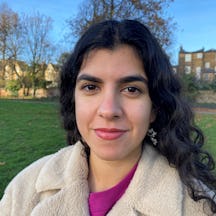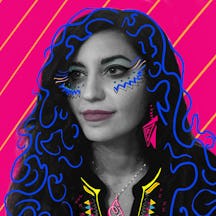Palestinian doctor Tawfiq Canaan documented the personal narratives behind every amulet in his collection, 220 of which he gave to Henry Wellcome’s collection. One modest necklace that caught the eye of Yasmeen Abdel Majeed as she worked at Wellcome Collection has allowed her to reveal its multilayered story.
In my first week working as a visitor experience assistant at Wellcome Collection, I noticed a blue-glass-bead evil-eye necklace. It wasn’t particularly large or bright, but it was labelled “Hebron, Palestine”. A tiny detail that should be taken for granted – that the Palestinian city of Hebron should be correctly classified – felt like the warmest welcome.
We Palestinians have come to expect the censorship of the word Palestine. Similar amulets in other museums have been labelled “Hebron, at that time situated in Palestine” or “Bethlehem, Israel”. Bethlehem and Hebron are today still part of the fraction of historic Palestine that is considered by the international community to be Palestinian territory, but Palestinians are accustomed to the erasure of their country everywhere from maps to museum labels.
Palestine is by no means unique: renaming places as a means of establishing legitimacy is a common colonial tactic. In 1948 Israel was established on Palestinian land, and since then, Israel has annexed more land and expanded to occupy almost all of historic Palestine. I was so happy to see the word Palestine in that glass case.
A carefully considered collection
Glass has been produced in Hebron for over 2,000 years, thriving until the late 20th century, when Israeli restrictions on the Palestinian economy caused the industry to struggle. The evil-eye symbol on the necklace is even older: dating back to 3300 BCE. The term ‘evil eye’ refers to both curse and cure. A look or expression of admiration or envy has the power to cause misfortune to the receiver. The amulet protects the wearer from the curse. Personally, I wear a blue-beaded bracelet and hang a charm outside my front door.
The earliest evil-eye amulets, excavated in modern-day Syria, were made of alabaster. The blue came later, from ancient Egypt. Cobalt and copper oxide in Egyptian mud added the pigment, and the story of Horus, who gave his father his own blue eye to eat, gave the colour resonance. Greeks and Romans carried the idea and tradition as far west as Britain, and the belief is now common in East Africa, South Asia and Latin America.
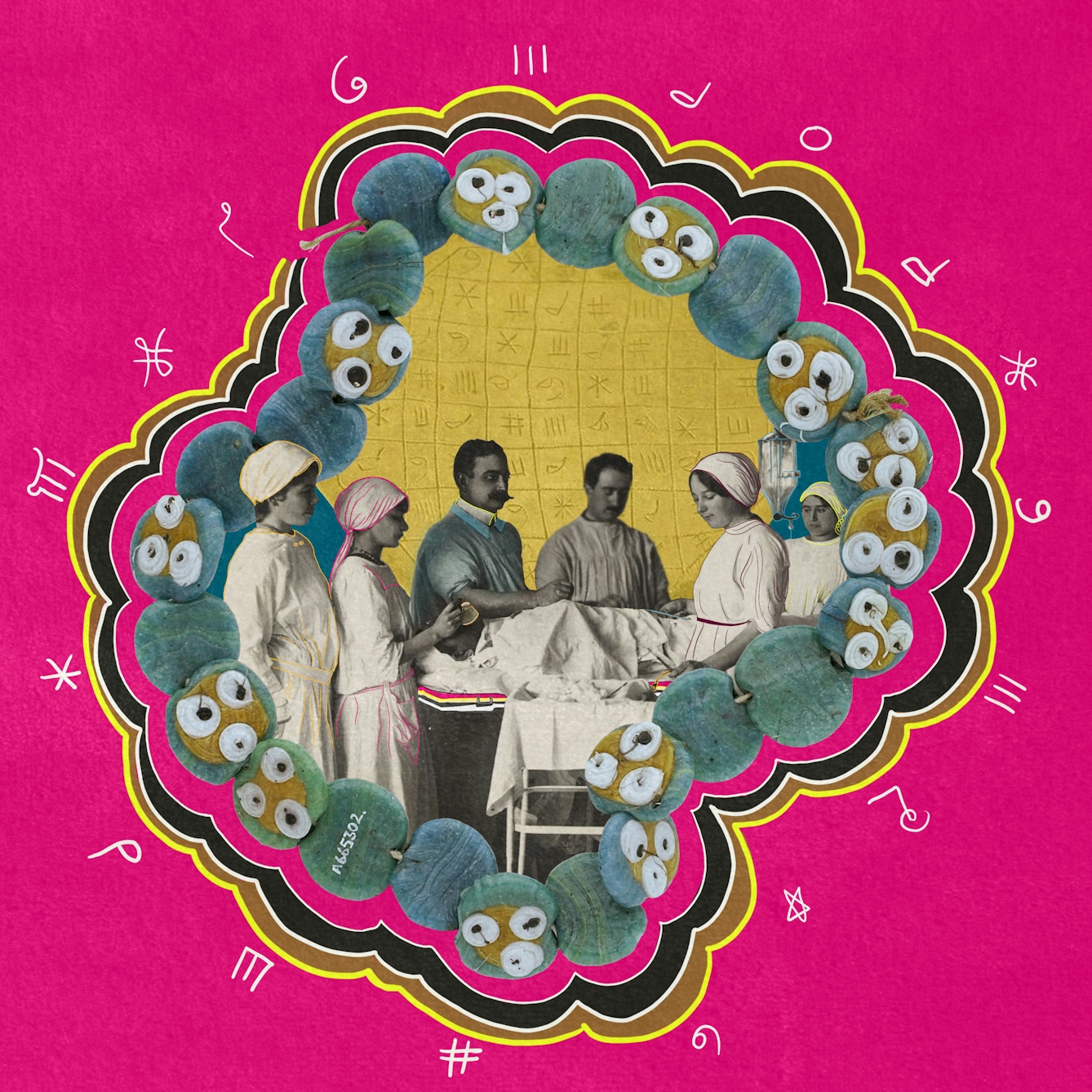
“Canaan was a medical doctor, credited with the eradication of leprosy from Palestine, but he was also an ethnographer and collector.”
I became curious about the amulet’s provenance, and it felt like fate when, three weeks into my new job, I found out that Henry Wellcome’s collectors had purchased over 200 amulets from Tawfiq Canaan, a Palestinian collector, for Wellcome’s Historical Medical Museum in 1930–31. Wellcome wanted Canaan’s full collection, but Canaan had refused to sell. Canaan was a medical doctor, credited with the eradication of leprosy from Palestine, but he was also an ethnographer and collector. Canaan mentions the museum proudly in his memoir:
“This interest in folklore study stimulated in me the desire to make a collection of amulets and talismans used in popular medicine to protect against and to cure disease. Slowly, I possessed the biggest collection from Palestine. Sir [Henry] Wellcome, the founder of the medico-historical museum in London, on hearing about my collection, asked through his friend Mr Saint-John [Peter Johnston-Saint], to secure him one. I was able to send him a collection of 220 pieces.”
We don’t know Canaan’s motivation for the transaction. It’s likely that he was enthusiastic that Palestine should be represented in the collection of a prestigious global businessman. Canaan had published nationalist pamphlets in English and German advocating for Palestinian independence, and was arrested by the British for his nationalist advocacy in 1939. He may have felt it his duty to present the Palestinian cause to German and English readers, whose governments had already expressed support for the Zionist ambition to establish a Jewish homeland in Palestine.
Many of his patients came to him wearing amulets, and he would talk to the patients about what the amulets could do.
Tawfiq Canaan cared deeply about his collection of amulets, and knew every object intimately. He began collecting through his practice as a doctor. Many of his patients came to him wearing amulets, and he would talk to the patients about what the amulets could do. He often bought them or took them instead of payment for treatment and medicine, noting the patient’s story and cataloguing the new object meticulously.
He started collecting in 1905, and by 1947 he had around 1,400 pieces. This mode of collecting stands in stark contrast to Henry Wellcome, who amassed a collection of 1.5 million objects by the time of his death, through a network of agents, dealers and auctions. Items were acquired by the crateload, sometimes waiting years after shipment to London to be unpacked and catalogued. Only a small proportion of the collection was displayed at the Wellcome Historical Medical Museum, with the rest remaining in stores across London.
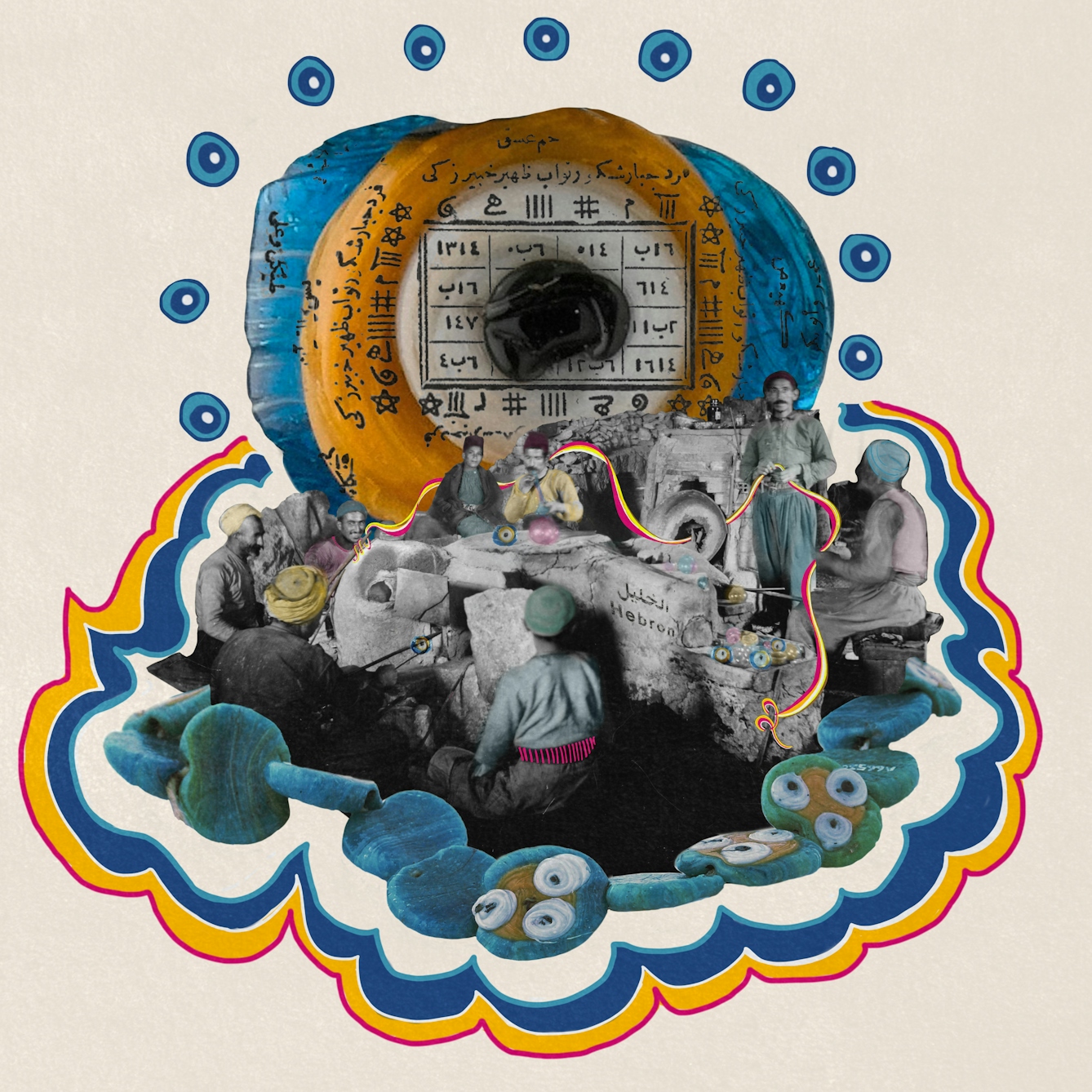
“Glass has been produced in Hebron for over 2,000 years and the evil-eye symbol on the necklace is even older: dating back to 3300 BCE.”
A complicated figure
Canaan was born in Beit Jala, Palestine in 1882. At the time, Palestine was an Ottoman territory, but French and British diplomats and missionaries were already well established, building the institutions of soft imperialism. The Germans followed a little later, hoping to inculcate the German language and cultural values, and build loyalties between Germany and an emerging Palestinian professional class.
Education was a key part of this strategy, and Canaan was educated at the German Lutheran Schneller School in Jerusalem, and at the Syrian Protestant College, now the American University of Beirut, both missionary institutions. He went on to become Palestine’s most important doctor, and a prolific writer on topics such as medicine, tropical disease, botany and folklore. Despite being educated in a Western tradition, he understood that the binary distinction between “modern medicine” and “folkloric medicine” was false, and that both systems were complimentary and interconnected.
Canaan is a complicated figure. He wrote mostly in English and German, raising the question of who he was preserving this heritage for. Certainly not those he wrote about. In addition, much of his scholarship was published by the Palestine Oriental Society, founded by Western scholars of the Holy Land.
Canaan was one of the only Arab members, and in his writings offers no critique of the motives of the foreign scholars that surrounded him. That said, many have argued that he employed their methods of ethnography and collecting in a way that subverted their colonial agenda. Travelling around Palestine, he recorded folklore and collected objects in the hope of establishing a body of knowledge that insisted on Palestinian worthiness, independence and belonging to the land, even if only to a Western and academic audience.
Canaan considered his subjects a dignified people: not an ethnographic ‘other’, but a culture that he belonged to. Sociologist Salim Tamari described him as a “nativist ethnographer” who wrote and collected in order to establish sources of legitimacy for Palestinian culture and national identity. In the early 20th century Palestinians had started to worry about Zionism and European imperialism’s claims to their land. Palestinian history was and still is mostly an oral tradition, but Canaan recognised that the day of needing to prove Palestinian existence in writing was coming.
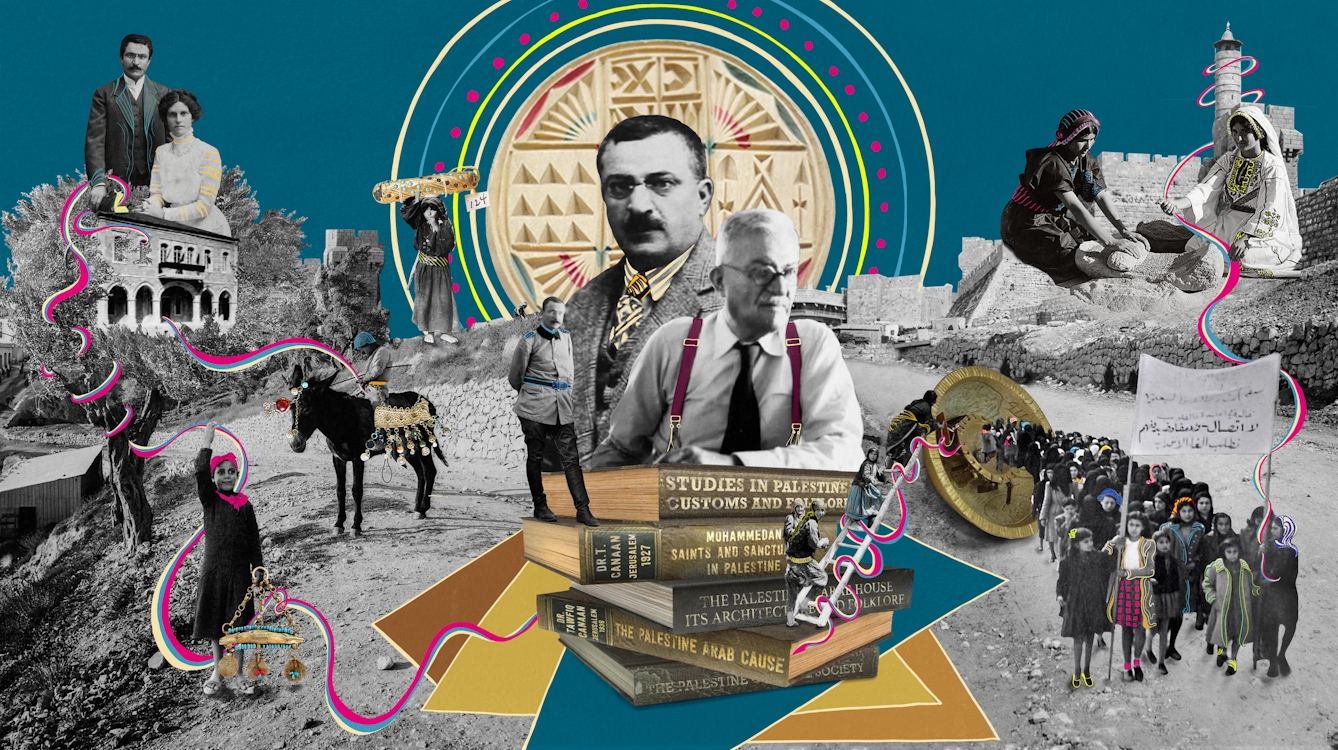
“Travelling around Palestine, Canaan recorded folklore and collected objects in the hope of establishing a body of knowledge that insisted on Palestinian worthiness, independence and belonging to the land.”
The politics of labelling
In May 1948, Tawfiq Canaan, along with 750,000 other Palestinians, was expelled from his home in the ethnic cleansing that Palestinians call the Nakba, or the catastrophe. His family fled to East Jerusalem and sought refuge in a monastery, where they spent two and a half years. From the monastery window, Canaan could see Zionist militias looting his library, and eventually setting his house on fire.
Three manuscripts ready for publication were lost for ever, but foresight had led Canaan to move his collection to secret storage in West Jerusalem before the war broke out. The amulets lay there for decades completely untouched, until his grandchildren were able to access them in the 1980s. The collection has since been given to Birzeit University in Palestine.
When I showed visitors the amulet in Wellcome Collection on my tours and proudly said it was from Palestine, I was occasionally met with resistance. Some visitors told me there were never any Arabs in Palestine and others complained about me to my manager for mentioning the birthplace of the amulet.
Despite the fact that Hebron is internationally recognised as Palestinian territory, Israel refuses to define its borders and is constantly annexing more land. Museums may see labelling an object as being from Israel as the safer option. However, museums create and shape knowledge, and so it is important that these institutions do not erase the word Palestine just to avoid being political.
Labels about colonised places will always be political. Museums should strive to fully understand the context of those places and make decisions about labelling based on the principles of justice and decolonisation.
Canaan’s amulets have ensured that the word Palestine remains at Wellcome Collection against the odds. The necklace and the collection it came from still represent Canaan’s dream of a free and independent Palestine. They were ambassadors for the cause, asserting Palestinian existence and connection to the land.
About the contributors
Yasmeen Abdel Majeed
Yasmeen is a Visitor Experience Assistant at Wellcome Collection. Her background is in history, and she is interested in the role that museums play in producing knowledge. Her research and public engagement focus is on colonialism, the environment, race and technology.
Jacqueline Reem Salloum
Jacqueline is an artist and filmmaker. Drawing on her Palestinian and Syrian roots, her multimedia-based artwork focuses on documenting histories and memories of people, including her family, that have been fragmented by displacement and exile. Salloum directed the award-winning feature documentary on the Palestinian hip-hop scene, ‘Slingshot Hip Hop’, which premiered at the Sundance Film Festival, along with her experimental short, ‘Planet of the Arabs’, which challenges the stereotypes of Arabs and Muslims in Hollywood.

